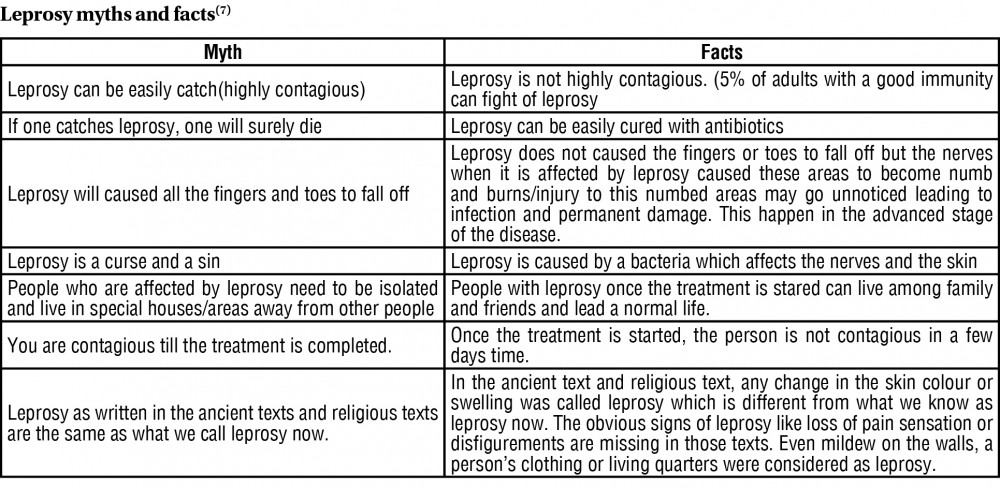
Dr Leishiwon Kumrah
CIHSR
The world Leprosy day is observed on the last Sunday of January. In 1953, the French humanitarian, Journalist and activist Raoul Follereau chose 30th January to coincide with the anniversary of Mahatma Gandhi’s death on 30th January 1948. On this day, awareness on leprosy, an ancient disease (which many believe to be extinct) and the people affected by it is done in various platforms like social media, radio, television etc...Today, it is not only the disease, but the people affected by it are forgotten too.
The theme for World Leprosy Day 2021 is “Beat Leprosy, End Stigma and Advocate for Mental Wellbeing”.
#Beat leprosy –spread the message that leprosy is curable
#End stigma – join the fight to end the stigma surrounding the people affected by leprosy
#Advocate for the Mental wellbeing – of those people affected by leprosy who have been neglected and forgotten.
Leprosy is a chronic infectious disease caused by Mycobacterium Leprae bacilli. It affects the nerve and the skin. If detected early and treatment in time, it is curable. But if there is a delayed in detecting it or in initiating treatment, it can caused deformity of the affected part.
It is one of the neglected tropical diseases affecting those in poverty, poor housing, overcrowding and therefore affects most those in the underserved communities(1)The loss of sensation and the various forms of deformity associated with it cause stigma and discrimination of those affected by it(2).This social stigma and discrimination severely affects the social existence of those affected by it in terms of marriage, job etc and this leads to delay in the health-seeking behaviour of those affected by it. This in turn leads to further spread of the disease.(3)
The Global burden of Leprosy
Though the number of people affected by leprosy is decreasing all over the world, India still contributes 60 %(4) of all the new cases of leprosy detected in the world which also includes children. Leprosy was declared eliminated as a world health issue by WHO in 2000 when the case detection fell to 1/10,000 population. This word “Elimination” was equated to eradication by many people including medical professionals, creating confusions in the minds of people all around the world. By “Elimination” WHO meant that the number of Leprosy cases detected around the world is less than 1/10,000 which India reached in 2005. This however does not mean that leprosy has been eliminated totally from India or the world. This misconception about the elimination has led many in the community and even in the medical profession to develop a false sense of security about it leading to delay in diagnosis and treatment.
Persistent problem of leprosy
i. A decline in a political and financial commitment.
ii. Research has not progressed much in terms of understanding it further.
iii. Lack/declined in skilled manpower and lack of training of the MPHWs or even Doctors
iv. The worrisome emergence of resistance to treatment and the lack of evidence based alternative to the old regime is worrisome.(5)
The way forward to overcome these issues:
i. Strengthen the existing Leprosy eradication program
ii. Create mass awareness about leprosy through Community participation to reduce stigma and discrimination
iii. Encourage health seeking behaviour of the affected person by promoting self reporting through incentivising along with active case detection through the existing health care system. This should also mean involving the private health care providers through sensitisation and training.(6)
iv. Reaffirm political commitment through active advocacy to sustain the existing programme.
What can you do to help and what is your part?
Leprosy still affects people and many are fearful of seeking help because of the stigma and discrimination. Leprosy is curable and the medicines are freely available. The treatment for leprosy is free and provided by the Government. This awareness need to be disseminated to all in the community.
You can educate yourself and your friends about leprosy being a curable disease.
You can create a positive image of leprosy by having an awareness campaign in your area of influence.
You can encourage people with signs or symptoms of leprosy to seek help early and inform them that the treatment is available free in case they have leprosy.
World Leprosy Day is observed annually on the last Sunday of January. In India, it is celebrated on January 30, the death anniversary of Mahatma Gandhi.
The author is a Senior Consultant and Head of Department, Department of Dermatology, Venereology, Leprology and Cosmetology, Christian Institute of Health Sciences and Research, 4th Mile Dimapur, Nagaland.
References:
1. Training Manual for Medical Officers [Internet]. New Delhi; 2013. Available from: http://nlep.nic.in/guide.html.
2. Jacob JT, Franco-Paredes C. The stigmatization of leprosy in India and its impact on future approaches to elimination and control. PLoS Negl Trop Dis 2008;2:e113.
3. Marahatta S, Ghimire A, Jha N, Pokhrel SM, Rayamajhi S, Jirel S. Social stigma in leprosy. J Chitwan Med Coll 2015;5:6-10.
4. NLEP Annual Report 2016-2017. New Delhi; 2017.
5. Galhotra A, Panigrahi SK, Pal A. Leprosy–A raging persistent enigma. J Family Med Prim Care 2019;8:1863-6
6. Rao N, Sujal S. Current situation of leprosy in India and its future implications. Indian Dermatol Online J 2017;8:487-9.
7. CDC: World Leprosy Day, Bust the myths, learn the facts




